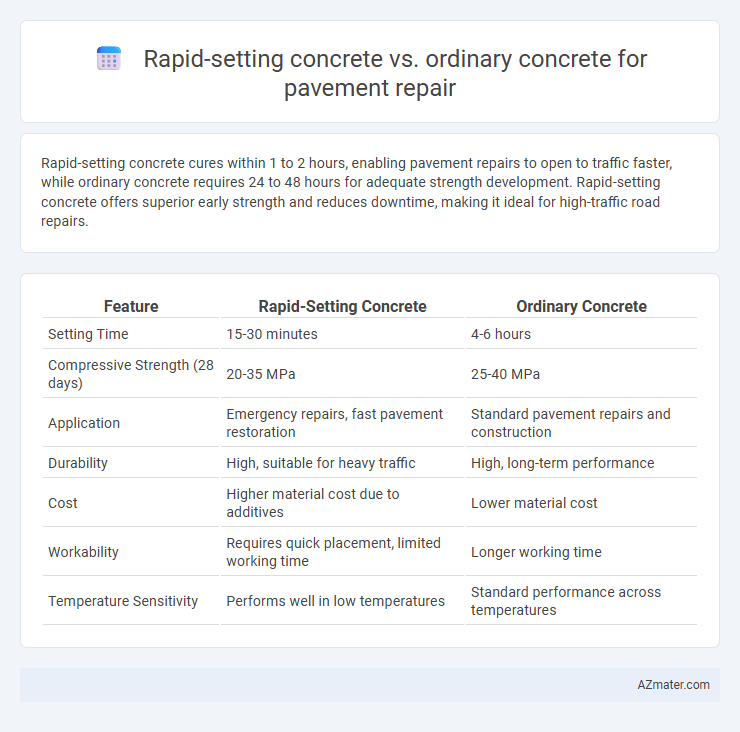Rapid-setting concrete cures within 1 to 2 hours, enabling pavement repairs to open to traffic faster, while ordinary concrete requires 24 to 48 hours for adequate strength development. Rapid-setting concrete offers superior early strength and reduces downtime, making it ideal for high-traffic road repairs.
Table of Comparison
| Feature | Rapid-Setting Concrete | Ordinary Concrete |
|---|---|---|
| Setting Time | 15-30 minutes | 4-6 hours |
| Compressive Strength (28 days) | 20-35 MPa | 25-40 MPa |
| Application | Emergency repairs, fast pavement restoration | Standard pavement repairs and construction |
| Durability | High, suitable for heavy traffic | High, long-term performance |
| Cost | Higher material cost due to additives | Lower material cost |
| Workability | Requires quick placement, limited working time | Longer working time |
| Temperature Sensitivity | Performs well in low temperatures | Standard performance across temperatures |
Introduction to Concrete Pavement Repair
Rapid-setting concrete for pavement repair offers significantly faster curing times compared to ordinary concrete, enabling quicker reopening of roads and minimizing traffic disruptions. Its high early strength and durability make it ideal for emergency repairs and locations requiring expedited service restoration. Ordinary concrete, while more cost-effective, typically requires longer curing periods, delaying pavement usability and potentially increasing maintenance windows.
What is Rapid-Setting Concrete?
Rapid-setting concrete is a specialized high-performance material designed to achieve early strength and durability within hours, making it ideal for urgent pavement repair. It typically contains fast-hardening cementitious compounds and chemical accelerators that significantly reduce curing time compared to ordinary concrete, which can take days to reach substantial strength. This quick curing property allows rapid-setting concrete to minimize traffic downtime and restore pavement functionality much faster than traditional mixes.
Understanding Ordinary Concrete
Ordinary concrete, widely used for pavement repair, consists of cement, water, aggregates, and admixtures that cure slowly, typically reaching sufficient strength in 28 days. Its predictable strength development and cost-effectiveness make it suitable for large-scale, non-urgent repairs where extended downtime is acceptable. However, slower setting times can lead to longer traffic disruptions compared to rapid-setting concrete alternatives.
Composition Differences: Rapid-Setting vs Ordinary Concrete
Rapid-setting concrete for pavement repair contains higher amounts of calcium aluminate or calcium sulfoaluminate cements, enabling faster hydration and strength gain compared to Ordinary concrete, which primarily uses Portland cement. The inclusion of special accelerators and finer aggregates in Rapid-setting mixes facilitates curing within hours, while Ordinary concrete typically requires days to achieve sufficient strength. This difference in composition ensures Rapid-setting concrete is ideal for time-sensitive repairs, minimizing pavement downtime effectively.
Installation and Curing Times Compared
Rapid-setting concrete for pavement repair significantly reduces installation and curing times, typically achieving initial set within 30 minutes and allowing reopening to traffic in 1 to 3 hours. Ordinary concrete generally requires an initial curing period of 24 to 48 hours before light traffic and up to 7 days for full strength development, delaying project completion. Faster curing of rapid-setting concrete minimizes downtime and improves traffic flow in infrastructure maintenance projects.
Strength and Durability Analysis
Rapid-setting concrete achieves compressive strengths exceeding 20 MPa within 3 hours, enabling faster pavement reopening compared to ordinary concrete, which typically reaches similar strength in 28 days. Its chemical admixtures enhance early hydration, resulting in improved resistance to freeze-thaw cycles and sulfate attack, while ordinary concrete exhibits moderate durability under such conditions. The accelerated strength gain of rapid-setting concrete reduces downtime for critical infrastructure, making it a preferred choice for time-sensitive pavement repairs requiring durable performance.
Cost Implications for Pavement Repairs
Rapid-setting concrete significantly reduces downtime due to its faster curing time, leading to lower labor and traffic management costs compared to ordinary concrete. Although the initial material cost of rapid-setting concrete is higher, the overall project expenses can be lower by minimizing road closure durations and associated economic disruptions. This cost-benefit dynamic makes rapid-setting concrete a preferred choice for time-sensitive pavement repairs in high-traffic areas.
Ideal Applications for Rapid-Setting Concrete
Rapid-setting concrete is ideal for pavement repair in high-traffic areas requiring quick reopening, such as airport runways, highways, and urban streets. Its fast curing time, often within one to three hours, minimizes downtime and reduces economic losses caused by extended road closures. This makes it especially suitable for emergency repairs and situations demanding early load-bearing capacity.
Limitations and Challenges of Each Concrete Type
Rapid-setting concrete offers quick curing times ideal for minimizing road closure, but its high cost and potential for lower long-term durability can limit usage in heavy traffic pavements. Ordinary concrete provides better long-term strength and durability but requires extended curing periods, leading to longer traffic disruptions and increased labor costs. Both types face challenges in achieving optimal bonding with existing pavement, temperature sensitivity, and susceptibility to shrinkage cracks during curing.
Choosing the Right Concrete for Pavement Repair
Rapid-setting concrete offers accelerated curing times, allowing pavement repairs to reopen quickly and minimize traffic disruptions. Ordinary concrete provides greater durability and strength for long-term pavement performance but requires longer curing periods. Selecting the appropriate concrete depends on project urgency, expected load, and environmental conditions to balance repair speed and durability.

Infographic: Rapid-setting concrete vs Ordinary concrete for Pavement repair
 azmater.com
azmater.com